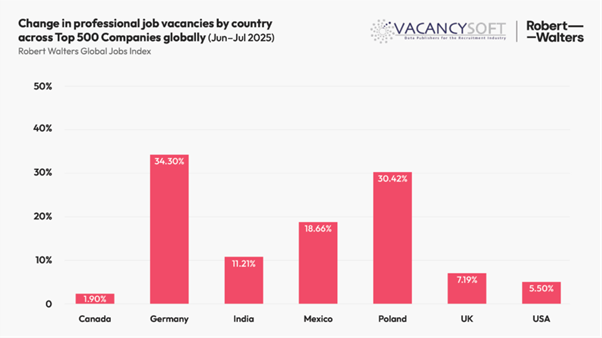Robert Walters Global Jobs Index: August 2025
19 August 2025
Volume of professional job vacancies picks up across the world’s largest businesses in July.
- Vacancies in the world’s 500 largest businesses up +9.2% in July compared to June, with Germany (+34.3%), and Poland (+30.4%) among the strongest performers.
- Tax Advisory and Corporate Tax vacancies hit record 2025 levels, with corporate tax vacancies in July accounting for 39% of tax vacancies this year.
- US hiring rose +5.5% compared to June, led by Financial Services (+11.8%) and Healthcare (+6.2%).
- UK vacancies increased +7.2% in July vs June, driven by gains in Financial Services (+10.2%) and Energy & Utilities (+13.8%).
Global professional job vacancies saw a +9.2% month-on-month increase in July compared to June. The increases were broad-based across the majority of the top 10 countries, although the drivers were concentrated in sectors where recruitment is more closely tied to regulatory obligations, infrastructure delivery or critical service provision.
“July’s data points to an uptick in hiring demand in areas where hiring delays can create operational or compliance risk such as tax, financial services and healthcare,” says Toby Fowlston, CEO at Robert Walters. “While this is welcomed, one month’s increase in vacancies should not be interpreted as a full market rebound. Instead, it shows businesses are focusing their recruitment on specialist roles essential to ongoing operations and skills that are harder to source.”
The findings come from Robert Walters Global Jobs Index, published today on Tuesday 19 August in partnership with Vacancysoft. It is the only index of its kind to track job flow for professional roles across the globe by looking at external job adverts posted online in real time.
Tax roles on the rise
Tax roles increased by +13% in July compared to June, making it the third-busiest month of 2025 for tax hiring after March and May.
Within this, Corporate Tax and Tax Advisory roles both recorded their highest monthly totals of the year so far. For corporate tax specifically, July accounted for 39% of all vacancies posted in 2025 to date.
Toby adds, “The increase in July was driven by demand for highly specialised tax expertise, particularly in corporate and advisory roles. These are critical functions where recruitment is closely tied to compliance cycles and regulatory deadlines, so hiring activity tends to remain robust even in more cautious markets.”

Germany and Poland record strongest growth overall
Germany recorded the largest increase among major economies, with vacancies up +34.3% in July. Financial Services saw the sharpest growth (+44.8%), alongside gains in Tech, Media and Telecoms (+38.0%) and Healthcare (+26.2%).
“While one month’s data can be influenced by project-specific hiring, the increased level of activity in Germany suggests firms are now recruiting for some of the roles they had paused earlier in the year,” comments Toby. “In finance, there’s been an uptick in demand across regulatory compliance, risk management, AI, and sustainable finance, with many firms also looking to bring in early-career professionals as part of longer-term workforce planning. This focus on future capability is also evident in technology, where fresh investment in AI, cloud infrastructure, and device upgrades is driving demand. While in healthcare, hiring is being driven by the needs of an ageing population and initiatives to expand medical and support services.”
Poland also posted strong results (+30.4%), supported by Healthcare (+21.7%) and Professional Services (+13.9%).
Toby adds, “In Poland, the growth spans both domestic and nearshore operations, reinforcing its position as a key location for shared services and professional expertise within Central and Eastern Europe.”
Financial Services leads growth in the US
US hiring rose +5.5% in July, led by Financial Services (+11.8%) and Healthcare (+6.2%), while Tech, Media and Telecoms grew by +2.7%.
Toby says, “In the US, demand in financial services and healthcare continues to outpace the wider market. These are sectors where recruitment is often linked to regulatory cycles, client delivery and critical operations, which makes them more resilient to shifts in broader economic sentiment.”
UK sees gains in Finance, Energy, and Healthcare
The UK recorded a +7.2% month-on-month rise in vacancies amongst the top 500 companies globally compared to June, with Financial Services (+10.2%), Energy & Utilities (+13.8%), and Healthcare (+14.2%) all posting growth above the national average.
Toby notes, “UK hiring remains selective. In Financial Services, we saw targeted hiring for commercial roles across retail, construction, and engineering. Many employers are adopting a project-based or skills-specific approach to recruitment, a pattern that is especially visible in healthcare, where demand is being lifted by rising service needs and staff shortages.”
The Robert Walters Global Jobs Index, developed in partnership with Vacancysoft, tracks job advertisements across the world’s leading companies and provides real-time insight into the evolving demand for white-collar professionals.
For Media Enquiries
Carmen Walker
PR Manager
E: Carmen.walker@robertwalters.com
T: 020 7509 8481
Related content
View All20 May 2025. Global white-collar vacancies fall -11.6% in April 2025 compared to March 2025 Hiring for AI and data roles remains resilient – Machine learning vacancies grow +27% in April, with demand shifting toward infrastructure and engineering skills USA sees -16.2% drop in April 2025 vacancies v
Read MoreMarch Sees Global Uptick in Professional Job Growth, but future impact of US trade tariffs remains to be seen Global white-collar vacancies jump +31% in March 2025 compared to February 2025 across all industries following a month-on-month decline in February USA sees +38% rise in vacancies in March
Read MoreUSA (+4.43%), UK (+7.27%), and Poland (+3.34%) were the only countries in Top 10 to post more white-collar vacancies in February vs January 2025 -8.29% decline in professional roles globally in February 2025 (vs Jan ’25) Industrials (+9.83%), Energy & Utilities (+6.90%), and Consumer Goods & Service
Read More.png)